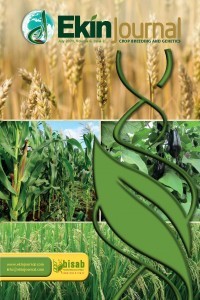Comparison of Two and Six-rowed Barley (Hordeum vulgare L.) Genotypes under Rainfed Conditions for Yield, Quality and Biotic Stress Tolerance
Comparison of Two and Six-rowed Barley (Hordeum vulgare L.) Genotypes under Rainfed Conditions for Yield, Quality and Biotic Stress Tolerance
Barley, genotype, grain yield, quality parameter, biotic stress,
___
- Bacher J, Wenzig K and Vogler M, (2004). SPSS two-step cluster - a first evaluation. Univ. Erlangennürnb. 1:1-20
- Chiu T, Fang D, Chen J, Wang Y and Jeris C, (2001). A robust and scalable clustering algorithm for mixed type attributes in a large database environment, in Proceedings of the Seventh ACM SIGKDD International Conference on Knowledge Discovery and Data Mining - KDD ’01, (New York, NY: ACM Press), 263-268.
- Couture L, (1980). Assessment of severity of foliage diseases of cereals in cooperative evaluation tests. Can. Plant Dis. Surv. 60:8-10.
- Gomez KA and Gomez AA, (1984). Statistical procedures for agricultural research. 2nd Ed. John Willey and Sons, Inc. New York. 641.
- Gouis Le J, (1992). A comparison between two and
six-row winter barley genotypes for aboveground dry matter production and distribution.
Agronomie, EDP Sciences, 12(2):163-171.
- Gupta M, Abu-Ghannam N and Gallaghar E, (2010). Barley for brewing. Characteristic changes during malting, brewing and applications of its by-products. Comprehensive Reviews in Food Science and Food Safety 9:318-328. https://doi. org/10.1111/j.1541-4337.2010.00112.x
- Kandic V, Dodig D, Secanski M, Prodanovic S, Brankovic G and Titan P, (2019). Grain yield, agronomic traits, and protein content of two- and six-row barley genotypes under terminal drought conditions. Chilean Journal of Agricultural Research 79(4):648-657.
- Kandic V, Dodig D, Zoric M, Nikolic A, Surlan Momirovic G, Kaitovic Z, Aleksic G and Duric N, (2018). Grain filling parameters of two-and six-rowed barley genotypes in terminal drought conditions. Italian Journal of Agrometeorology, 23(2):5-14.
- Lang L, Rakszegi M and Bedo Z, (2013). Cereal production and its characteristics. Engineering aspects of cereal and cereal-based products. CRC Press, Boca Raton, Florida, USA.
- Marwat SK, Hashimi M, Usman Khan K, Aslam Khan M, Shoaib M and Rehman F, (2012). Barley (Hordeum vulgare L.) a prophetic food mentioned in Ahadith and its ethnobotanical importance. American-Eurasian Journal of Agricultural and Environmental Sciences. 12:835-841.
- Öztürk İ, (2019). Comparison of two and six-rowed barley (Hordeum vulgare L.) genotypes based on yield and agronomic characters. Agriculture & Food. 7:75-85.
- Öztürk İ, Avcı R, Girgin VC, Kahraman T, Şili S, Kılıç TH, Vulchev D, Valcheva D and Goceva M, (2018). Effect of biomass at different growth stages on yield and agronomic characters in barley (Hordeum vulgare L.) cultivars. Agriculture & Food, 6:15-25. 2018
- Przulj N and Momcilovic V, (2012). Spring barley performances in the Pannonian zone. Genetika. 44(3):499-512.
- Reid JF, Choo TM, Ho KM, Martin RA and Konishi T, (2001). Comparisons of two-row and six-row barley for chemical composition using doubledhaploid lines. Crop Sci. 41:1737-1743. Saari EE and Prescott JM, (1975). A scale for appraising the foliar intensity of wheat diseases. Plant. Dis. Rep. 59:377-380.
- Ward JH, (1963). Hierarchical grouping to optimize an objective function. J. Am. Stat. Assoc. 58:236- 244.
- Zadoks J, Chang T and Konzak C, (1974). A decimal code for the growth stages of cereals. Weed Research 14:415-421.
- Zwirek M, Waugh R and McKim SM, (2019). Interaction between row type genes in barley controls meristem determinacy and reveals novel routes to improved grain. New Phytologist 221:1950-1965. https://doi.org/10.1111/ nph.15548.
- ISSN: 2149-1275
- Yayın Aralığı: Yılda 2 Sayı
- Başlangıç: 2015
- Yayıncı: Bitki Islahçıları Alt Birliği
Accelerated Pepper Breeding Using Molecular Markers and Doubled Haploidy Technique
Mesut NAR, Hande Nur ALBEZİRGAN1, Burcu D EMİRKAYA, Hakan FİDAN, Hakan AKTAŞ, Ş. Şebnem ELLİALTIOĞLU
Registration of "Samsoy" Soybean [Glycine max (L.) Merr.] Variety
Mehmet ERDOĞMUŞ, Meral ERGİN, Serkan YILMAZ, Seyit Ahmet EROL, Celal BAYRAM
Pardeep KUMAR, Pritam YADAV, Pravin Kumar SHARMA, Machiavelli SINGH, Rishi K. BEHL
Registration of “Bossa 159” Cotton (Gossypium hirsutum L.) Variety
Parul RANA, Om P. BISHNOI, Harsh CHAURASIA, Rishi K. BEHL
Registration of “Sayım 40” Winter Barley (Hordeum vulgare L.) Variety
Namuk ERGÜN, İsmail SAYİM, Sinan AYDOĞAN, Melih BİLİR, Emre KARAHAN, Gülden Çetin ÖZKAN
Surinder Singh BISHT, Rishi K. BEHL, Chander KISHOR, Rajesh Kumar ARYA
Registration of “Sinanbey” Winter Feed Barley (Hordeum vulgare L.) Variety
Namuk ERGÜN, Sinan AYDOĞAN, İsmail SAYİM, Melih BİLİR, Emre KARAHAN, Gülden Çetin ÖZKAN
Renu MUNJAL, Jogender BENIWAL, Arjoo DHUNDWAL, Alisha GOYAL, Anita KUMARI, Rishi K. BEHL
Registration of “Fener” Eggplant (Solanum melongena L.) Variety
Ayşe KAHRAMAN, Mehmet Asım HAYTAOĞLU, Sevgi MUTLU, Seyfullah BİNBİR
